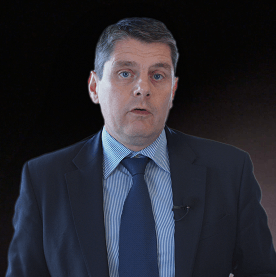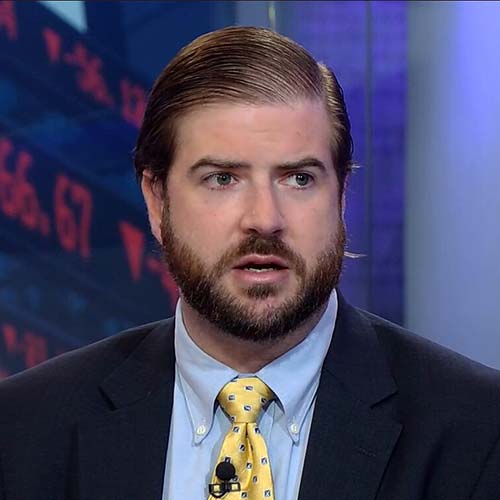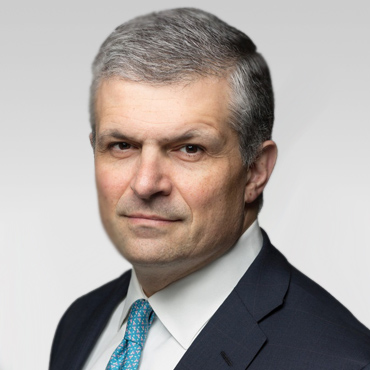U.S. Economic Outlook
What’s the big picture on the U.S. economy heading into 2025?
Frances Donald: The U.S. economy, while looking strong on the surface, is probably going to continue to have this K-shaped dynamic. Large corporations and higher-income households are benefiting from wealth impacts from really strong stock markets, much more so than lower-income households and smaller businesses.
Michael Reid: We see a lot of the momentum in 2024 carrying over into this new year. Our base case is that the economy continues to normalize, with GDP growth getting back towards 2%. We expect consumption will continue to drive GDP growth, despite a drag from lower and middle income consumers, who are bearing the brunt of higher prices and interest rates.
“Our base case is that the economy continues to normalize, with GDP growth getting back towards 2%.”
Michael Reid, U.S. Economist, RBC Capital Markets
How do U.S. prospects compare in global terms?
Donald: U.S. exceptionalism is going to continue to be a huge theme in 2025 – maybe one that we increasingly consider not just cyclical, but structural in nature.
Some of this is fundamentally driven and sustainable. For example, productivity and the AI boom is really accruing mostly in the United States.
Some of it also has to do with extraordinary amounts of government spending in the U.S. that is just not matched elsewhere. That continues to lift growth, but the U.S. federal budget deficit is set to rise from $1.9 trillion currently up to $2.9 trillion by 2035. That's creating distortions in the data; it's making the Federal Reserve's job harder.
We have a very large expected spread between U.S. rates and the rest of the world. In the U.S.-Canadian story, particularly, we're expecting some of the largest divergence of rates that we've seen.
“U.S. exceptionalism is going to continue to be a huge theme in 2025 – maybe one that we increasingly consider not just cyclical, but structural in nature.”
Frances Donald, Chief Economist, RBC Capital Markets
What will be the key impacts of the change of government?
Donald: Some policies we know will probably lift growth, like deregulation, potential tax cuts. Then we know there will be policies that historically have been more challenging for growth: tariffs, of course, but also immigration policies that may reduce the amount of labor force available. Tariffs are complicated. They hit an economy in four stages. The first one we may start to see earlier, and that is a front-loading of activity. That can actually goose growth in the beginning. Then we tend to see the one-off price shock. Third step, a demand shock to the downside. And the fourth: do you then see some reshoring of activity that happens structurally?
Vito Sperduto: Our RBC Elements research team compiled a list of the most-discussed topics before and after the election. Unsurprisingly, tariffs surged in prominence post-election, particularly as Trump tweeted about them in relation to Canada, Mexico, and the BRIC countries. This raised questions about their purpose—are they strategic tools or simply negotiating tactics? Many still lean toward the latter interpretation.
Reid: Under his first term, Trump used trade policy and threats of tariffs as a tool to address issues like immigration. Ultimately, those tariffs were never implemented, especially for countries like Canada and Mexico. So our base case right now assumes a relatively limited implementation of tariffs in 2025.
We know that Trump is playing with the idea of lowering the corporate tax rate. That could help offset some of the potential threat of a pass-through of those input prices. So the full extent of consumers feeling higher prices as a result of these tariffs remains to be seen.
More importantly, the massive immigration inflows that were a key factor of loosening the labor market conditions in 2024 are starting to reverse right now. That's going to add to the number of job openings we're seeing, and that's going to potentially see a reacceleration in wage growth.
“The massive immigration inflows that were a key factor of loosening the labor market conditions in 2024 are starting to reverse – that's going to add to the number of job openings.”
Michael Reid, U.S. Economist, RBC Capital Markets
What other factors will influence the direction of inflation?
Donald: Historically, if you wanted to estimate inflation, you'd be thinking about demand side: the willingness and ability of people to go out and spend at a restaurant, or a company that wanted to expand. We’re spending more time thinking about different drivers of inflation now.
Interest rate policy doesn't impact geopolitical events any more. It doesn't change more frequent and severe weather, which has been very disruptive to our data and inflationary. I'm not sure markets have entirely caught yet that there will be a larger wedge between the inflation story and the interest rate story.
Reid: We’ve seen deflationary pressure of goods through much of 2024, but we don't expect to see goods prices decline on a sustained basis over a two-year period. Together with what we're seeing the labor market and how that impacts wage pressures, we think that really keeps the services component of inflation rather sticky.
Sperduto: Before the election, we thought clearly, we're now in a rate cutting cycle. Now, we're trying to get our arms around what policies are going to be put in place, more people are talking about the fact that at some point we're going to see a pause in ‘25.
Reid: We think the Fed is going to go on a pause after the January meeting, and that's also when we think housing prices bottom out and start to add inflationary pressure. Upward inflationary pressure, with a potential hiking bias by the end of 2025, is going to leave mortgage rates quite high relative to where they were back in 2021.
This higher rate environment is also weighing on new home builders. So ultimately, we think housing will continue to be a problem, and something that is really not easily addressed by the Fed and their interest rate policy.
“I'm not sure markets have entirely caught yet that there will be a larger wedge between the inflation story and the interest rate story.”
Frances Donald, Chief Economist, RBC Capital Markets
Can the Fed reach an equilibrium that protects consumers while suppressing inflation?
Donald: It's not a cop-out to say that the tails around the outlook are very fat. In an environment in which the economy is less interest rate sensitive, finding that level of neutral is going to be very difficult.
Reid: If the Fed leaves rates too high, that impacts a segment of the population that relies on credit for their consumption. Also, if programs to ease student loan debts are cut, you risk a growing burden of student loan debt on those lower income consumers.
What are the biggest risk factors to our outlook?
Reid: Right now, we're forecasting that the unemployment rate ends the year at under 4.5%, but if you see delayed retirements start to tick up, meaning that we don't see job openings, we run the risk of it running closer to 5% by year end.
Donald: If we have a Fed that doesn't quite sniff out that neutral rate and is too hawkish, that could spell trouble for small businesses who employ 80% of Americans. If we have trade conflicts that come earlier in 2025 than our current base case, that could knock our more resilient aggregate economy off its feet.
Canadian Economic Outlook
What are the main themes for Canada’s economy in 2025?
Lindsay Patrick: The world remains dynamic as we approach 2025. We have ongoing geopolitical conflicts, a new U.S. administration, slowing economic growth in China, and an unfolding climate transition—all of which will impact Canada.
Frances Donald: Uncertainty looms both within Canadian borders and abroad, fueled by conflicting economic narratives. It’s probably going to be a year of two halves. In the first half, Canada will continue to struggle with the weight of higher interest rates, rising unemployment rates, and some of the damage done by restrictive monetary policy. But interest rates are starting to decline in Canada, and we think by the tail-end of 2025 there’ll be some relief.
What will be the likely impact on Canada of the new U.S. administration?
Lindsay Patrick: The recent U.S. election has sparked many of our Canadian clients to question how a Donald Trump presidency and a Republican sweep could impact Canada’s economic landscape.
Frances Donald: Following the U.S. election results, we did downgrade our Canadian GDP forecast, because most of the policies that have been suggested increase the risk that Canada does a little worse in the next one to four years. However, we still don’t have full clarity on what policies are going to be implemented.
Trade is the first direct channel. If you look at a 10% blanket tariff on all goods, it would hit Canadian exports by 2 to 3%. Of course, a 25% blanket tariff would be substantially more problematic and likely economically unfeasible for both the United States and Canada. At the same time, Canada produces a lot of things that the U.S. can’t produce at home, like critical minerals, so they’ll have to be very careful.
If we see greater trade frictions between the U.S. and China, we may actually see closeness between the U.S. and Canada increase. Canada could see some benefit from the rise in protectionism, as we move away from global supply chains and towards more regional trading blocs.
Energy will remain key. Canada has invested, publicly and privately, a significant amount in the energy transition in the country. If the U.S. moves in another direction, that might change some of the dynamics in Canada as well.
Another way to assess the impact of the new U.S. administration is through immigration. With a push for stricter deportation policies in the U.S., Canada must consider the potential for an increase in asylum seekers.
How will the U.S. and Canadian economies stack up in 2025?
Frances Donald: Canada’s economy has fundamentally and perhaps permanently shifted away from the U.S. model. Potential growth between the two economies is now very different. We see growth potential for Canada dropping off towards 0.6% in the next few years.
In Canada, there really isn’t a buffer underlying the economy. That’s substantially different from the U.S. story, where we’ve seen a major productivity boom, in part driven by technology and the big investment in research.
We think this divergence between the U.S. and Canada is likely to persist probably for the next decade. It’s going to require some significant realignments before we can say we’ve improved the general health of the Canadian economy.
Our forecast is that the Bank of Canada should bring rates down to 2% over the course of 2025, but the Federal Reserve may get stuck around 4%.
The U.S. is spending more compared to the size of its GDP than it ever has outside of a recession, and debt to GDP is going to be the highest in its country’s history. That pro-cyclical fiscal spending is juicing the U.S. economy in a way that Canada’s relatively reserved fiscal spending is not.
“We think this divergence between the U.S. and Canada is likely to persist probably for the next decade... It’s going to require some significant realignments before we can say we’ve improved the general health of the Canadian economy.”
Frances Donald, Chief Economist, RBC
How will Canada’s immigration shift impact housing?
Lindsay Patrick: In the recent past, Canada embraced immigration to address labor shortage issues, but this has inadvertently strained sectors such as housing and driven a shift in public sentiment as a result. In response, the federal government has adjusted its approach, setting lower immigration targets for the coming years. Striking a balance between the economic benefits of immigration and the challenges it creates will be key moving forward.
Frances Donald: Prior to 2019, Canada’s approach to immigration was viewed as a major economic positive, a way to offset low natural population growth and strengthen the labor force. Canada has a productivity problem, and we were offsetting this with very high immigration.
When the labor shortage started to amplify during Covid, we more than doubled immigration in a very short period, with strong positive results. In the past few months, we’ve noticed that the unemployment rate for new arrivals has been much higher than for other Canadians. We’re clearly absorbing more immigrants than we can take, which is why the situation has become more problematic. That’s why we’ve seen this sizable change in immigration policy.
What’s so shocking about this is that the reduced immigration targets will wipe out population growth in Canada for the next two years. We have basically through this one policy collapsed the ability of the economy to grow. We have to address the affordability that has happened in housing, but there will be a period here that, at least on the surface data, makes the Canadian story appear worse.
How could Canada’s housing policies play out?
Frances Donald: Housing is an immigration story, a productivity story, a fiscal story. It flows through every part of the Canadian fabric. We believe addressing the supply side is key to solving Canada’s housing market crisis.
Declining interest rates are going to make the housing market busier in 2025. The easing of mortgage insurance rules is going to be significant.
We think that’s going to solve around half of the problem in affordability that’s accrued since the pandemic. But that still leaves us in deeply unaffordable territory.
The housing and affordability crises won’t be solved in 2025. They’re a long-term part of Canada’s economic DNA. We still have to find a solution.
“Housing is an immigration story, a productivity story, a fiscal story. It flows through every part of the Canadian fabric.”
Frances Donald, Chief Economist, RBC
European Economic Outlook
How have the events of 2024 left the European economies?
Janet Wilkinson: The landscape has shifted this year. Political and policy transitions in the U.S., E.U., U.K., and France, along with the ripple effects of heightened global geopolitical volatility, are reshaping the economic agenda with profound implications for markets, businesses and investors.
Peter Schaffrik: Growth in 2024 was better than expected. The firmness of the labor market is really one of the key central pillars – not only different to past hiking cycles, but with a clear structural element that might well drive us going into 2025.
Of course, inflation has also come down. That enabled the central banks to put a cutting cycle into motion.
Without any major deterioration in the labor market, which we do not foresee, it’s very unlikely that we’ll get a recession.
“Without any major deterioration in the labor market, which we do not foresee, it’s very unlikely that we’ll get a recession.”
Peter Schaffrik, Chief European Macro Strategist
What are the growth prospects for 2025?
Schaffrik: In the euro area as well as in the U.K., we're thinking about growth in the range of 1 to 1.5% – positive, but not stellar.
Real disposable income has gone up, but consumption has not. The question is whether that changes going forward. We have seen some tentative changes, but there's plenty of headwinds.
Cathal Kennedy: The domestically generated parts of the inflation basket, most noticeably services inflation, have yet to convincingly move downwards in either the U.K. or the euro area.
We think that the central dilemma is the productivity growth backdrop, which post-pandemic has gone from being weak to being either non-existent or negative.
What does that mean for rates?
Schaffrik: The ECB has communicated that they want to return interest rates to a neutral level. But that's a very elusive concept.
We have pencilled into our forecast 2.25%. That’s nearly two cuts above where the market sees it, making us a bit of an outlier.
Kennedy: The Bank of England is now advocating a much more gradual, cautious approach to the current cutting cycle, essentially because the October budget loosens fiscal policy in the near term.
The U.K. government has front-loaded day-to-day spending, creating fiscal stimulus. When taxes kick in from April, they fall mainly on employers in the form of a payroll tax. There’s some evidence that firms, particularly in the service sector, might look at employment as the way to pass that on.
What the bank is interested in is that interaction of that near-term fiscal stimulus with the changing behavior of employers.
“The Bank of England is interested in is the interaction of near-term fiscal stimulus with the changing behavior of employers.”
Cathal Kennedy, Senior U.K. Economist
How does political turmoil play into economic fortunes?
Schaffrik: What we’ve seen in France recently highlights how wide budget deficits and high debt levels can potentially move markets. On the other hand, you have the German budget that is very tight, and the government even fell over the big question about whether to widen the budget and support the economy. I'm pretty confident that after the elections, what we'll get is a different fiscal position out of the largest economy in the euro area, where we'll probably see support programs to stimulate the economy.
There is an increased focus now on using the EU's budget, or some kind of SPV, to specifically target military and security spending, which is probably something that the U.S. will push.
So the fiscal loosening we’ve already seen in the U.K. is going to be a key theme for 2025 in the euro area as well – in part voluntarily, but in part forced by the new U.S. administration.
“The fiscal loosening we’ve already seen in the U.K. is going to be a key theme for 2025 in the euro area as well.”
Peter Schaffrik, Chief European Macro Strategist
What are the implications if trade tariffs are imposed by the new U.S. administration?
Schaffrik: Tariffs, by and large, are negative for Europe, no doubt about that. The question is whether they are also inflationary.
In one scenario, U.S. introduction of tariffs on China could see more Chinese products come into Europe, maybe at a discounted price, which is disinflationary. But there's obviously an alternative scenario where the U.S. strongarms the Europeans to introduce restrictions against China themselves.
We assume that we will get some kind of tariffs. It's not entirely clear what magnitude and what sequence they will take. On balance, they're probably going to be negative for growth, and at least initially, inflationary.
What are investors’ current perspectives?
Schaffrik: Most of our clients are expecting a relatively negative 2025 and therefore quite a lot of rate cuts.
If we are right, and inflation remains a bit more sticky in all European economies, the ECB is likely to cut less than expected and pause at 2.25% whilst the BoE is likely to remain in the slow lane, ending the cutting cycle near 3.75%. If you then extend that into the longer end of the yield curve, we find it difficult to see how duration can perform this year. We recommend short-duration assets in pretty much all markets that we look at.
If you look at ultra-long dated assets, the issue of debt sustainability and widened fiscal policy that we spoke about earlier might be an additional burden for them.
Wilkinson: At senior business levels, geopolitical risks and the uncertainty they bring are top of mind. We all know that the institutional asset management market in the U.K. and Europe, and globally, is under immense cost pressure, and there's a strong move to passive funds. The uncertainty around growth in the markets puts even greater pressure on this.
To end on a bit of a high, there's a really strong outlook for M&A and associated deal activity, and for corporate credit, where yields are still high.
“There's a really strong outlook for M&A and associated deal activity, and for corporate credit, where yields are still high.”
Janet Wilkinson, Managing Director, Head of Global Markets Flow Sales, EMEA
Australian Economic Outlook
How does Australia’s economy stand as we move into 2025?
Rod Ireland: Growth is weak as we head into 2025 driven largely by public demand with subdued household consumption and private activity public demand. Inflation remains a challenge with the Reserve Bank of Australia maintaining a cautious stance. Rates have been on hold at 4.35% since November 2023, despite the global easing cycle.
Su-Lin Ong: There has been some real weakness in household disposable income. Income tax cuts kicked in from July, among a bunch of cost of living measures, so that should help lift income and consumption over the next 12 to 18 months, but so far, it’s been pretty patchy with households opting to save/pay down debt. A firmer 2025 hinges on some improvement in household consumption.
Public spending is likely to remain strong as we head into a federal election cycle by May 2025. Public demand in Australia has been rising for some time: it's almost 30% of GDP now.
“Growth is weak as we head into 2025 supported largely by public demand. Firmer growth next year hinges on some pickup in household consumption.”
Rod Ireland, Head of Global Markets, APAC, RBC Capital Markets
What are the factors driving the inflation and employment outlook?
Ong: The key upside surprise is the labor market in Australia, which has been remarkably resilient despite very weak growth. We do think, though, that the weakening in overall demand and the broader economy will see the unemployment rate rise over 2025, towards 4.5%.
That, in turn,should help out on the inflation front. As in most places around the world, inflation has continued to moderate over the last 12 months, but it is still too high. Productivity is really weak in Australia, a key factor in the growth outlook and inflation challenges.
What’s the likely impact of U.S. policy under the new administration?
Ong: What we're focused on most closely is anything that hits Australia's major trading partner, China. The discussion around tariffs, potentially at 60% or higher, is obviously really significant. We have adjusted our export forecasts down slightly for next year and 2026 to try to capture some of that.
Rob Thompson: The risks to market pricing are just magnified by potential geopolitical eruptions, in either direction. We've certainly discussed scenarios where, if you had sanctions posed on China, markets like Australia might be recipients of more Chinese goods – so could actually be some deflationary forces as well.
How will Australia’s policy stance shape fixed income markets?
Ong: We do think that some loosening up in the labor market, and inflation continuing to move clearly towards target 2 to 3%, will give the RBA scope to deliver some modest easing next year. Our base case is for two 25 basis point cuts in May and August with the risk it begins earlier in Feb.
Rob Thompson: The bank itself is signaling a position towards eventual cash rate cuts, which has allowed markets to start to price a bit more easing. That in turn, has allowed some of our bond yields, particularly front end, to really start to drop away.
We're not going to completely unlink from global bond yields, and particularly from the U.S. You could see some bond yields underperform in both. Elsewhere, in Europe especially, yields are looking like they could stay low or drop further. Divergence does open up more opportunities for directional trades between countries for investors.
“Loosening up in the labor market, and inflation continuing to move clearly towards target, will give the RBA scope to deliver some modest easing next year.”
Su-Lin Ong, Chief Economist, APAC, RBC Capital Markets
How are housing and infrastructure playing in to the overall picture?
Ong: Housing is very high on the list of concerns for Australians. It is likely to be front of mind for policymakers. The national house price index is at a record level: house prices are up about 40% from their pre-Covid levels.
There's been a reliance on subsidies to help first homeowners, in particular, but all that does ultimately is lift house prices. Supply side measures are needed. The federal government has a very ambitious target of 1.2 million new dwellings over the next five years. This is ambitious given multiple headwinds – elevated building costs, shortage of construction labour, and long approval times.
Thompson: We've seen a real explosion of infrastructure spending, especially on the Eastern Seaboard. That has meant a lot more fiscal pressure on the state side: they've needed to fund a lot more through the bond market.
The increase in the size of the semi-government debt market has also increased spreads to bonds. It’s made these bonds more attractive to investors, but also raised some questions over longer-term fiscal sustainability, given the pace of debt increases.
What’s been the economic impact of population growth?
Thompson: It's clearly additive to growth and to inflation – definitely a challenge for the Reserve Bank and other policymakers to try and allow for this level of extra people coming into the country.
It will be very challenging for the government to realize its forecasts for a drop in net migration over the next couple of years.
“It will be very challenging for the government to realize its forecasts for a drop in net migration over the next couple of years.”
Rob Thompson, Macro Rates Strategist, APAC, RBC Capital Markets
What are the biggest risks to your outlook?
Ong: History shows that it's usually external shock that causes the most disruption. A world that is more protectionist, with lower trade volumes, never bodes particularly well for a small, open economy like Australia.
My other worry is a consumer that doesn't revive, that continues to save. We would definitely see a much weaker economy and labor market as a result.
Thompson: Perhaps the labor market will actually soften more than we expect. That could result in a very different outcome for inflation. But at the moment, we think Australia is more like the U.S., in terms of looking pretty strong, even if it's for different reasons, relative to some of the weaker developed markets.









